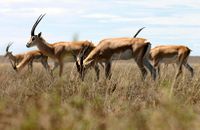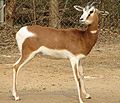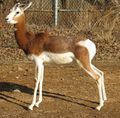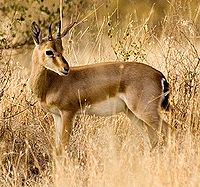Gazelle
| Gazelle | |
|---|---|
 |
|
| Thomson's Gazelle | |
| Scientific classification | |
| Kingdom: | Animalia |
| Phylum: | Chordata |
| Class: | Mammalia |
| Order: | Artiodactyla |
| Family: | Bovidae |
| Subfamily: | Antilopinae |
| Genus: | Gazella Blainville, 1816 |
| Species | |
|
Several, see text |
|
A gazelle is any of many antelope species currently or formerly in the genus Gazella. Six species are included in two genera (Eudorcas and Nanger) which were formerly considered subgenera. The genus Procapra has also been considered a subgenus of Gazella, and its members are also referred to as gazelles; however they are not dealt with in this article.
Gazelles are known as swift animals – some are able to maintain speeds as high as 50 miles per hour (80 km/h) for extended periods of time.[1] Gazelles are mostly found in the deserts, grasslands and savannas of Africa, but they are also found in southwest and central Asia, and the Indian Subcontinent. They tend to live in herds and will eat less coarse, easily digestible plants and leaves.
The gazelle species are classified in the Gazella, Eudorcas and Nanger. The taxonomy of these genera is a confused one, and the classification of species and subspecies has been an unsettled issue. Currently, the genus Gazella is widely considered to contain about 13 species. Four further species are extinct – the Red Gazelle, the Arabian Gazelle, the Queen of Sheba's Gazelle and the Saudi Gazelle. Most surviving gazelle species are considered threatened to varying degrees.
One widely familiar gazelle is the African species Thomson's Gazelle (Eudorcas thomsoni), which is around 53 to 66 cm (21 to 26 in) in height at the shoulder and is coloured brown and white with a distinguishing black stripe (as in the picture on the right). The males have long, often curved, horns. Like many other prey species, Tommies (as they are familiarly called) exhibit a distinctive behaviour of stotting (running slowly and jumping high before fleeing) when they are threatened by predators such as lions or cheetahs. This is a primary piece of evidence for the handicap principle advanced by Amotz Zahavi in the study of animal communication and behaviour.
Contents |
Etymology and name
Gazelle is derived from the Arabic ghazăl (Arabic: غزال).[2] The first Latin language to adopt it was Middle French, and the word entered the English language around 1600 from the French.[3] Arab people traditionally hunted the gazelle. Appreciated for its grace, it is a symbol most commonly associated in Arabic literature with female beauty.[4] One of the traditional themes of Arabic love poetry involves comparing the gazelle with the beloved, and linguists theorize that ghazal, the word for love poetry in Arabic, is related to the word for gazelle.[5] It is related that the Caliph Abd al-Malik (646-705) freed a gazelle he had captured because of her resemblance to his beloved:
O likeness of Layla, never fear!
For I am your friend, today, O wild deer!
Then I say, after freeing her from her fetters:
You are free for the sake of Layla, for ever![5]
Species[6]
- Genus Gazella
- Subgenus Gazella
- Mountain Gazelle, G. gazella
- Neumann's Gazelle, G. erlangeri
- Speke's Gazelle, G. spekei
- Dorcas Gazelle, G. dorcas
- Chinkara, also known as Indian Gazelle, G. bennettii
- Subgenus Trachelocele
- Cuvier's Gazelle, G. cuvieri
- Rhim Gazelle, G. leptoceros
- Goitered Gazelle, G. subgutturosa
- Subgenus Gazella
- Genus Eudorcas
- Mongalla Gazelle, E. albonotata
- Thomson's Gazelle, E. thomsoni
- Red-fronted Gazelle, E. rufifrons
- Genus Nanger
- Dama Gazelle, N. dama
- Grant's Gazelle, N. granti
- Soemmerring's Gazelle, N. soemmerringii
Extinct
Fossils of genus Gazella are found in Pliocene and Pleistocene deposits of Eurasia and Africa. The tiny Gazella borbonica is one of the earliest European gazelles, characterized by its small size and short legs. Gazelles disappeared from Europe at the start of Ice Age, but they survived in Africa and Middle East. Four species became extinct in recent times due to human causes.
Recent extinctions
- Genus Gazella
- Genus Eudorcas
- Red Gazelle, E. rufina
Prehistoric extinctions
- Genus Gazella
- Gazella borbonica - European Gazelle
- Gazella thomasi' - Thomas's Gazelle
- Gazella praethomsoni
- Gazella negevensis
- Gazella triquetrucornis
- Gazella negevensis
- Gazella capricornis'
- Subgenus Vetagazella
- Gazella sinensis
- Gazella deperdita
- Gazella pilgrimi- Steppe Gazelle
- Gazella leile - Leile's Gazelle
- Gazella praegaudryi - Japanese Gazelle
- Gazella gaudryi
- Gazella paotehensis
- Gazella dorcadoides
- Gazella altidens
- Gazella mongolica - Mongolian Gazelle
- Gazella lydekkeri - Ice Age Gazelle
- Gazella blacki
- Gazella parasinensis
- Gazella kueitensis
- Gazella paragutturosa
- Subgenus Gazella
- Gazella janenschi
- Subgenus Trachelocele
- Gazella atlantica
- Gazella tingitana
- Subgenus Deprezia
- Gazella psolea
- Genus Nanger
- Nanger vanhoepeni
Gallery
 Grant's Gazelle |
 Mhorr Gazelle |
Cuvier's Gazelle |
 Grant's Gazelle |
 Mhorr Gazelle |
 Thomson's Gazelle |
 Goitered Gazelle |
 Chinkara |
 Dorcas Gazelle |
 Cuvier's Gazelle |
 Red-fronted Gazelle |
References
- ↑ The Twisted Mind Emporium: Weird Science: Fast Animals
- ↑ Walter, Henriette; Fawcett, Peter D. (1994). Peter D. Fawcett. ed. French inside out: the worldwide development of the French language in the past, the present and the future (Illustrated ed.). Routledge. p. 66. ISBN 0415076692, 9780415076692. http://books.google.ca/books?id=n3wOAAAAQAAJ&pg=PA66&dq=%27gazelle%27+Arabic+etymology&lr=&cd=50#v=onepage&q=%27gazelle%27%20Arabic%20etymology&f=false.
- ↑ Merriam-Webster - Gazelle, Accessed: December 22, 2009
- ↑ Behrens-Abouseif, Doris (1999). Beauty in Arabic culture (Illustrated ed.). Markus Wiener Publishers. p. 53. ISBN 1558761993, 9781558761995. http://books.google.ca/books?id=GQ2aFwUR3mgC&pg=PA53&dq=%27gazelle%27+Arabic&lr=&cd=4#v=onepage&q=%27gazelle%27%20Arabic&f=false.
- ↑ 5.0 5.1 Necipoğlu, Gülru (1997). Gülru Necipoğlu. ed. Muqarnas: An Annual on the Visual Culture of the Islamic World (Illustrated ed.). BRILL. ISBN 9004108726, 9789004108721. http://books.google.ca/books?id=s6MN2T9cXNEC&pg=PA15&dq=gazelle+arabic+ghazal+love&cd=1#v=onepage&q=gazelle%20arabic%20ghazal%20love&f=false.
- ↑ "Antilopinae". http://www.ultimateungulate.com/Cetartiodactyla/Antilopinae.html. Retrieved 2008-07-01.
- ↑ Participants at 4th International Conservation Workshop for the Threatened Fauna of Arabi 2003. Gazella saudiya. In: IUCN 2006. 2006 IUCN Red List of Threatened Species. <www.iucnredlist.org>. Downloaded on 07 October 2006.
- ↑ IUCN SSC Antelope Specialist Group 2008. Gazella saudiya. In: IUCN 2008. 2008 IUCN Red List of Threatened Species. <www.iucnredlist.org>. Downloaded on 18 December 2008.
|
||||||||||||||||||||||||||||||||||||||||||||||||||||||||||||||||||||||||||||||||||||||||||||||||||||||||||||||||||||||||||||||||||||||||||||||||||||||||||||||||||||||||||||||||||||||||||||||||||||||||||||||||||||||||||||||||||||||||||||||||||||||||||||||||||||||||||||||||||||||||||||||||||||||||||||||||||||||||||||||||||||||||||||||||||||||||||||||||||||||||||||||||||||||||||||||||||||